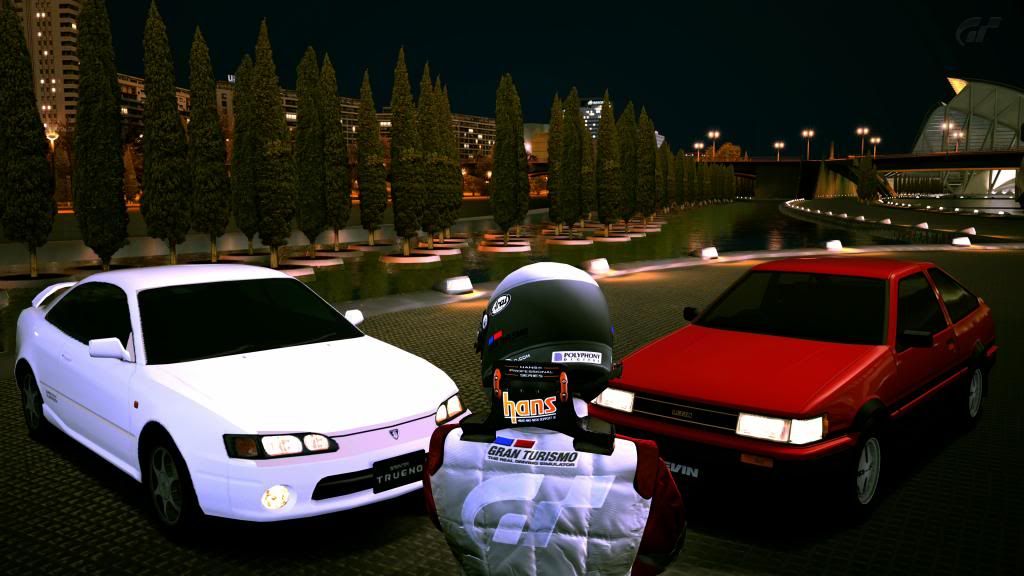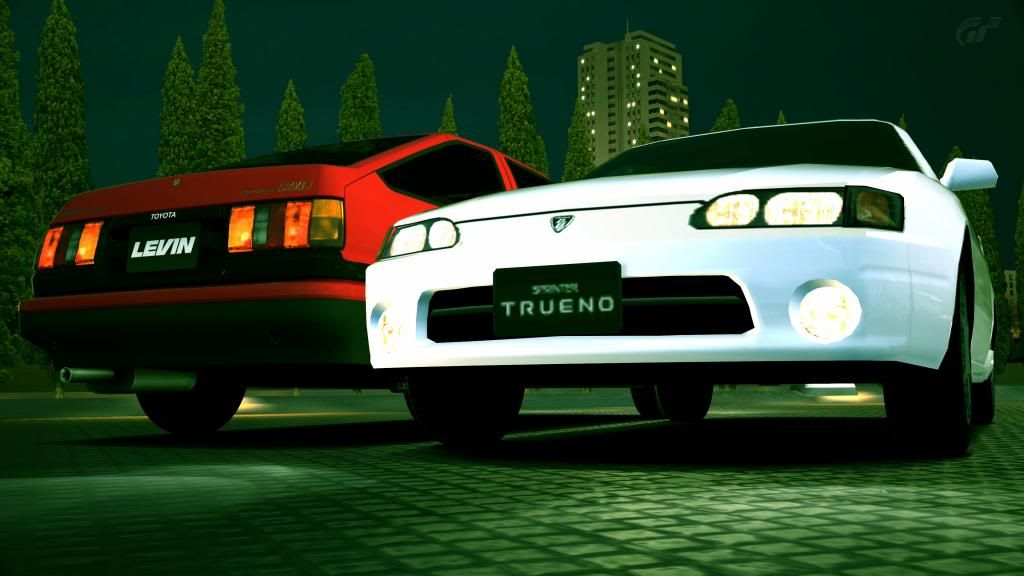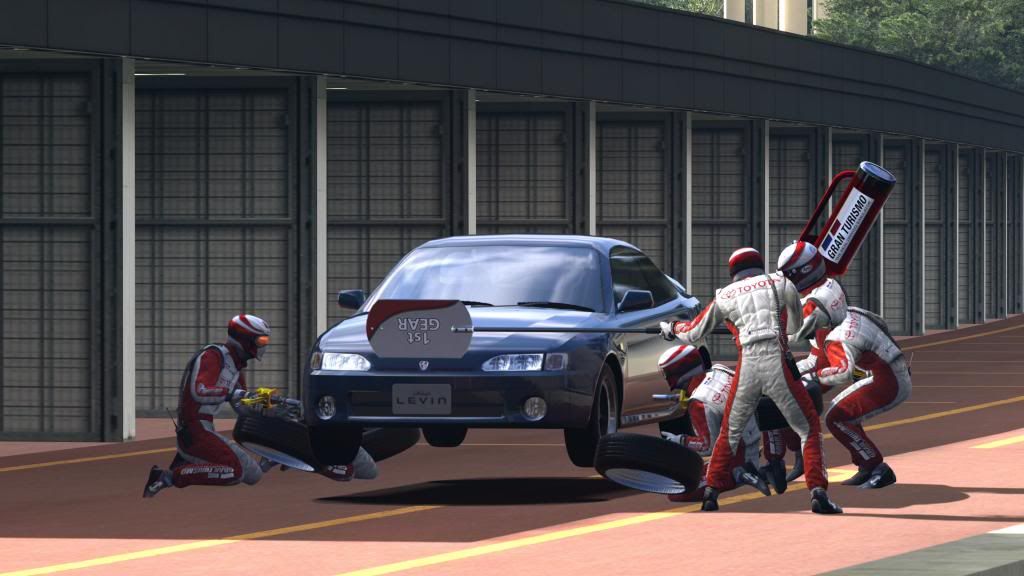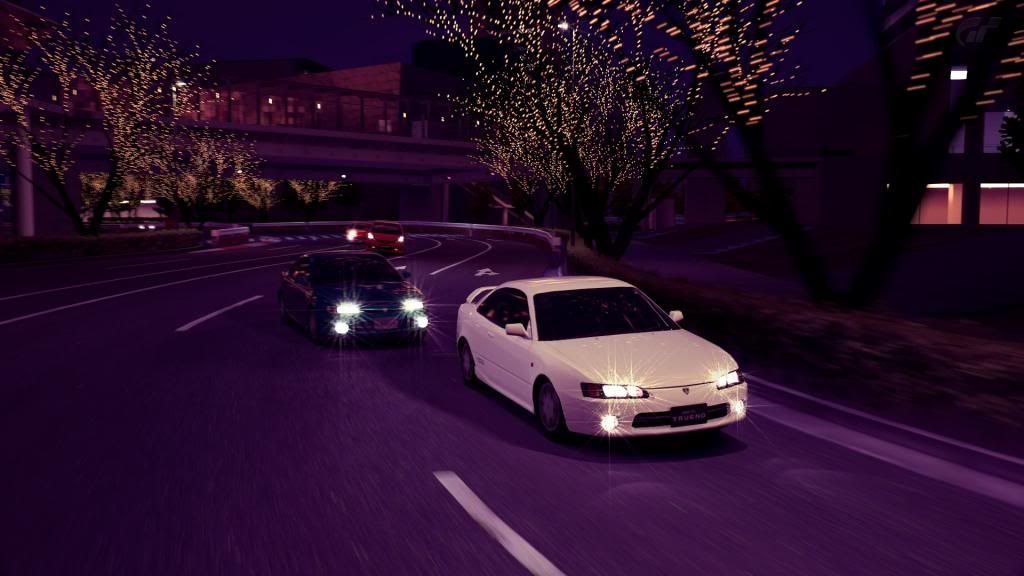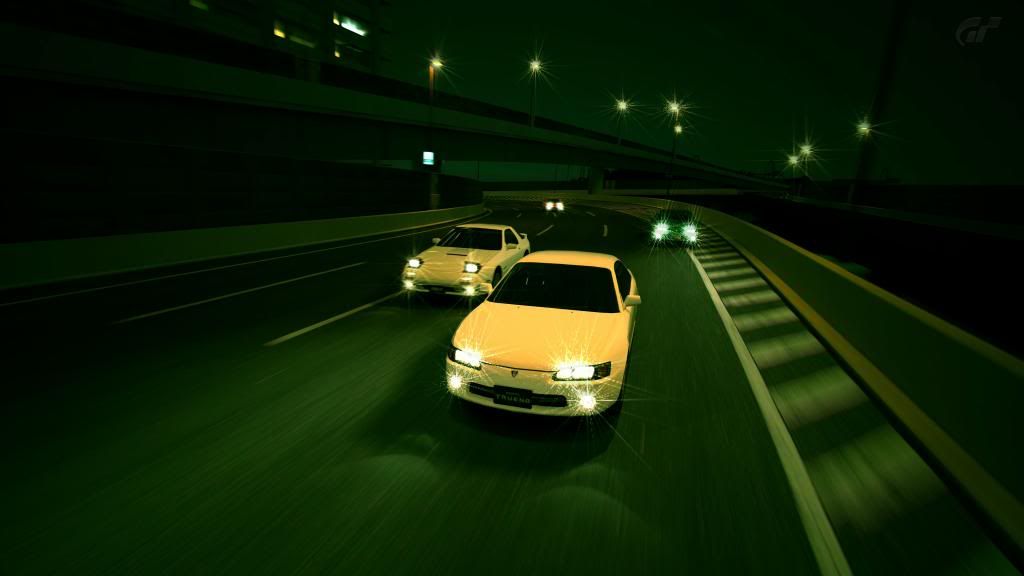"That is how he wants to race. It's not racing." -Ayrton Senna
Why on Earth are we still here? (Editor: So you can test another car.)
It's been nearly two months since I've been able to enjoy the comforts of my own bed, in my own house, in my own country. Two months missing my beautiful wife, my wonderful daughter, and god only knows the drama I'll walk into when I get back. Despite my lack of authority over our crew, the car choices or anything else in Japan, I'm sure that I'll shoulder all of the blame the minute I walk through the front door. Even though my wife knows that traveling for long periods is part of the job, I'll still be the one to blame for being gone this long. I can also look forward to all the chores that weren't done while I was away, because hiring someone to cut the grass or fix the garage door defies the whole reason why my wife married me. Quite simply, I'm not much more than cheaper labor.
You might think that's a bit sexist, but then you haven't spent a day with my wife. Everything has its own order and place, and mine is planted firmly beneath her heel. You might think that I'm a bit crazy for willingly participating in such an archaic domestic situation, but it does have its advantages, rare as they may be. You see, my wife has an incredible ability to make meals that delight the soul. If one taste is heaven, then one meal is the entire kingdom of every deity known to man. She's also responsible for the Americans beating the Russians at ice hockey in 1980, the Red Sox breaking their curse in 2004, and the return of the Twinkie. So you see, by every other account she's a saint, her three miracles guaranteed to place here in the great halls of Catholicism, even though I receive the Inquisition for my misdeeds. Or perceived misdeeds. Why do I love her? Well, much like the cars we test, I'm a glutton for abuse. That, and she can do this thing with her tongue...

So why are we still in Japan? (Editor: Because that's where this car was born. At this rate we won't be going anywhere else anytime soon. Do you mind?)
Previously we've sampled the goods of Infiniti and Acura, the Japanese luxury market created for Americans that wanted a gussied-up means of transportation, but lacked the funding to acquire anything conventional. Or they lacked the taste. So you might think that, naturally, we'd go after the third installment of Japanese luxury-meets-freedom fries, Lexus. But you'd be wrong. Although we've just finished with the Toyota factory tour, we'll have none of that badge-engineered garbage this week. This week, we skip the Plaza Accord altogether and get a taste of the apple from The Tree of Knowledge, likely with similar side effects.
The forbidden fruit bequeathed to us this week comes in two flavors, but don't let the marketing fool you. Although they are the same car, the relationship between the two requires that both be made, or none at all. You can select one or the other, but if one isn't available, you're not likely to find the other, either. Sold in separate stores, we've united the complimenting pair in an effort to see if technology really does improve the breed, or if it's a case of too many cooks spoiling the broth. Over any given period of time, does automotive evolution occur according to Charles Darwin, or are we left to ponder the machinations of some invisible man in the clouds, dependent entirely on its mood on any given day? In short, we're testing automobile evolution versus questionably intelligent design.
According to Polyphony Digital (via Translator-san):
"A full model change to the Levin/Trueno in May 1995 marked the arrival of the seventh-generation version, also known as the AE111. The AE111 was the complete opposite of its predecessor, the AE101, because it did away with the luxuries that defined the previous car, partly because Toyota wanted to reestablish the model as a sporty brand. As a result the AE111 became a lighter car, thoroughly trimmed down, 70 kg lighter than before."
"There were obvious deletions in the lineup as well. The supercharged engined that graced the model's top lines, such as the BZ-G was gone, replaced by the naturally aspirated 5-valve-per-cylinder 4A-GE. But Toyota tuned this inline-4 to produce162 HP/119.3 ft-lb of torque, essentially matching the output of the previous supercharged engine."
"The suspension system remained basically the same as the AE101, iwth a helical LSD dramatically improving the car's turning abilities. In 1997, the BZ-G was renamed the BZ-R and received a 6-speed manual transmission. The car became a bit heavier at this point because of the implementation of an airbag and other safety equipment required by law. As a result, the car lost its luster among young enthusiasts, many of whom were already beginning to trade in their sports coupes for small SUVs and wagons. In 2000, the Levin/Trueno was removed from the Corolla lineup, marking an end to this affordable enthusiasts-oriented model."
Contrary to popular belief, Darwin never said "only the strong survive." The Tyrannosaurus Rex was plenty strong, but even it couldn't handle the impact of one measly little comet. Instead, Darwin claimed that animals capable of adaption would be the ones that last the longest, which is a good thing when you consider what hunting a T-Rex capable of withstanding a nuclear explosion would be like. The good folk of Japan have even provided examples of such nonsense, each with varying degrees of success. Despite that, I can truthfully say that no part of Japan has been wiped out due to an overgrown lizard from the sea. At least not yet. We're constantly reminded that history shows, again and again, how nature points out the folly of man.
Automotive evolution is no different, and as Translator-san has already said, these cars fell victim to their inability to adapt to their environment. As we mentioned when we tested the Volvo Estate, the 1990s brought with it the peak of the Sports Utility vehicle, itself an evolution of military transport trucks decades before. Although it isn't entirely a new species, you've seen how it's now evolved into crossovers and so called "light utility" vehicles, for people that want the appearance of a SUV without the eco-killing labels that come with them. They also don't want the negative connotations usually associated with estates, even though what they've chosen is undeniably worse than what they actually need. You might call it "natural selection", but the way I see it, nature is a **** that doesn't know what she needs and only chooses what she wants. How can the strongest survive if it isn't pretty enough? Hummer, for instance.
Performance (as purchased): February 15, 2014, Super White II (White) *'98 Sprinter Trueno as shown, but both are the same.
Displacement: 1,587 cc
Max. Power: 193 HP @ 8,800 rpm
Max. Torque: 127.9 ft-lb @ 6,300 rpm
Drivetrain: FF
Length: 169.5 in., Height: 51.4 in., Width: 66.7 in., Weight: 1,080 kg
Tires: Comfort (Soft)
Performance Points: 393
Mileage: 208.4 mi
Why? Are there no cars made anywhere other than Japan anymore? (Editor: There are, but none of them were chosen for you.)
In sports and in life, there's nothing I relish more than being underestimated. Be it racing on the track, playing poker with friends, or even fixing the dishwasher, there's nothing more satisfying from making those that believe "you can't" eat their words. Likewise, it's when we find a car that exceeds our expectations that we know we've found a winner. The Primera, case in point, wasn't expected to be as fun to drive as it was, and the same could be said for the Peugeot RCZ from Week 1. Both are front-wheel drive, yet despite that, they still managed to put a smile across our faces. Rather than bask in the typical stereotype of each, they seem to relish it, as if to say "oh yeah, well I know something you don't". It was with those two in mind that we tested the CL Type-S, and failing miserably, contemplated suicide soon after. Plus, everyone loves cheering for an underdog every now and then.
Even though we expected to test a Lexus based on recent selections, our expectations were tweaked with the promise of something more sporty than luxury. But when we found out that it was the 111, and not the infamous haichi roku, I must admit that the leap to conclusions was of Olympic proportions. Why would Toyota take a simple formula for success and cock it up by making the switch to front-wheel drive? Much as every other enthusiast, we didn't care about the economic implications, and frankly we still don't want to. Having had the pleasure of testing the AE86 once before, I couldn't see why Toyota would change anything about it. Except, the power on tap, that car was perfect in every way. It had seat belts, terrific handling, and could get you down a mountain in little time while making passengers cringe at the sight of the road's edge. Who could ask for anything more?
Apparently, the general public. Much as the aforementioned Mother Nature, so too is the public; ***** that don't know what they want. Back home I get loads of questions from potential buyers, each eager for my opinion on what car to purchase next. Every one of those request begins with flowery praise of the insights I've previously offered, but when I make a suggestion it's immediately ignored as if I haven't a clue of what I'm talking about. Doctors don't face this sort of slap in the face when they prescribe treatment for cancer and attorneys don't when they offer legal advice, yet every time I give my opinion about a potential purchase it's as if I were speaking to a brick wall. Actually, I'd probably have better luck with the wall. Despite getting a list of automotive needs and referencing that with available options, whenever someone asks about a car they should buy, I've learned that their mind is already made up and can't be changed or persuaded. Aside from wanting to retain my soul, this is also why I don't sell cars.
So it comes as no surprise, then, that this is the end of the line for the Levin/Trueno. Sad, really, because even though Toyota screwed up the layout in the generation prior, this is actually a very good car. The Corolla name is known worldwide for selling by the boat load, yet after the AE92, these versions weren't offered in America. Available with a 6-speed manual (unheard of today), a boy racer spoiler, ABS, better brakes and something called the "Super Strut Suspension". This combination is more dynamite than "Thunder" and "Lightning", from where the names derive, respectively. Compared with the daft American offerings such as the Escort/Topaz and Cavalier/Sunfire, this car is actually sporty without the need to put silly stickers on the fender or grotesque stripes down the middle. Not only that, but unlike the Topaz and Cavalier, you won't be ridiculed for being seen in one. Although not listed from the factory, "respect" comes standard on each model, so it really doesn't matter which one you chose.
Why don't we have any say in the cars we test? (Editor: You have about the same amount that you have in how much you do/don't get paid. Get on with it!)
While we can theorize and debate evolution and intelligent design for eternity, but to paraphrase famous physicist Niels Bohr, "science works even if you don't believe in it." I've already mentioned my initial misgivings about the change from rear to front-wheel drive as a viable adaptation of the species before us. Plainly it wasn't enough to save it from extinction, perhaps only borrowing a few years before the inevitable visit from the Reapers Grim. Still, having a theory is one thing, but putting it into practice is another entirely. Instead of speculation on the reasons for this adaptation, it is worth seeing them placed side by side to compare the effects. As such, we were able to acquire a few local roads to watch nature take its course. Much like Sir Charles (Editor: not Sir Charles) visiting the Galapagos, we'd be observing evolution and its role in our own automotive ecosystem.
To watch nature take its course, we've selected the Twin Rings of Motegi to pit RWD against FWD. While we would've preferred to sample these cars in their natural environment, we simply couldn't obtain the permits needed and no insurance company on Earth would guarantee funding should one or both end up through the middle of a shop if I got something wrong. Even though we had local heroes Super Aguri preparing the cars and ensuring their safety, it seems that the insurance agencies caught wind of a certain escapade involving a Buick, and wanted absolutely nothing to do with what we had planned. While you might save some cash by visiting their website, I wouldn't expect their support if you happen to document your escapades for the world to see, as we do. "Fund a teenager to flog a car down a mountain? Sure! $57,000, please. That guy? HELL NO."
Up first was the father, the progenitor, the passer of genes, the AE86. Much has been written and said about the legendary abilities of these cars, but I cannot stress enough the "fun factor" that they provide. In order to reach the car's potential, however, they must be driven completely flat out, ten-tenths the entire time. Although there isn't much power, there is enough to keep the car well positioned, quick to react and with enough feedback to rival a CNN ticker at the bottom of your television screen. By today's standards, the car is a bit antiquated inside the interior, but when you're careening sideways down a mountain road, the last thing on your mind is the fabrics and plastics used. Being inexpensive, the materials chosen do their job well, in some cases beating out American cars costing three times as much, like the Corvette. Using every one of the 136 horses on tap, I was able to coax a 1:46.980 from our Levin, which felt respectable even though we hadn't yet had a chance to test its grandchild.
Whenever you see lightning, thunder is usually soon to follow, so naturally we chose the Sprinter Trueno to follow up behind the Levin. The difference in layout didn't really take much to get used to thanks to the cars we've previously tested from Nissan and Honda. Even though the Trueno has a similar differential to the Honda, this tricky diff did what the Honda couldn't... it turned. For a front-wheel drive, it actually turned well, the radius of which being completely predictable and manageable. In the Honda you had to guess the entry speed before making an attempt, and that was after you'd scrubbed off what you hoped would be enough speed to see the other side. Conversely, the Trueno carried the momentum throughout the turn, occasionally suggesting that a faster response mid-turn would yield a better exit. If the Honda could be compared to a dog dragging its arse across a lawn, the same could be said of the Trueno, only as a cat instead. Even though it weighs more than the AE86 Levin, the extra mass doesn't feel like an encumbrance, gliding through turns like a ballerina on her toes. The stopwatch and my derriere both agreed, the 1:43.908 was faster.
Why doesn't this make any sense? (Editor: Probably because you can't be trusted to choose anything other expensive hypercars with unpronounceable names. Keep going, we haven't got all day!)
No, I mean why doesn't the evolution make any sense (although we'll discuss that when I'm finished)? Logic dictates that the switch from rear to front-wheel drive would ruin the car by limiting its capabilities. It's safe to assume that had this been rear-wheel drive, we'd likely would've shaved off even more time than the three whole seconds we already have! That'd place the Trueno in musclecar territory, and before you protest, let me remind you that the Mustangs and Camaros of the era had similar power output. The horsepower gap between this and the AE86 would be about the same as between it and the Mustang GT, yet I'm sure that extra horsepower in the GT would be wasted by the live-axle in the back, and that this Trueno would still end up with a better time!
Therein lies what nearly every enthusiasts skips over, simply because it isn't sexy and has no perceived relationship to going faster. Economics. In motorsport, the speed you travel is only limited by the budget you offer, and when making a car the same is true. Compared with rear-wheel drive cars, front-wheel drives have less components, which equals costs savings. Although the Plaza Accord is often credited with the creation of the Japanese luxury market, it's also the cause of what eventually killed the Trueno. The whiplash effect and unintended consequences of the Plaza Accord lead to an economic shortfall, which could've been foreseen had the automakers produced all of their cars in America, much closer to the raw materials needed to do so. In most cases, they didn't, requiring raw materials to be imported before a car could be created and exported. It wasn't as if Japan was going to stumble across a mountain of ore they didn't realize they'd had, like the manner in which you might find extra cash in the pocket of a winter coat. With the boom comes a bust, and this bust took cheap RWD fun with it, and is currently in the process of also taking the manual transmission.
Why can't we get someone to choose cars from another country? (You were applied to be a presenter, not director of Human Resources, remember? Wrap it up, it's time for lunch!)
In 1926 Sakichi Toyoda founded Toyota, then a textile company known for various patents on automatic looms. It was he that introduced the concept of Jidoka, meaning autonomous automation, and this meant that when a production machine had a problem it'd simply stop itself. Before then, many accidents occurred when workers failed to notice quality issues, resulting in machinery run amok and lots of explosions. He also gave us the 5 Whys, an important tool used to get to the root cause of production problems and ensure their prompt correction, which is still being used today in many, many other industries. He also gave us Kiichiro Toyoda, his son, who would go on to create the automotive branch that still produces cars today. By disassembling and dissecting a Chevrolet, he and his team were able to reverse-engineer a car and create a production process, improving it constantly. This eventually enabled a young Soichiro Honda to continue piston rings, later becoming Toyota's automotive rival.
Competition is directly responsible for evolution, and it's the brave that welcome competition and improvement. While this may be the end of the road for the Sprinter and Trueno, evolution has once again crept up to offer adaptations to fit the environment, and the new GT86 species now fills the void left by the AE86. Even Subaru's BRZ carried over a few letters of the name, albeit in a different order, it's still practically the same as the GT86. That's a good thing, because we've been without an underdog like this for quite sometime, and without them, we'd never learn the speed of lighting and roar of thunder. These cars and I share a kinship, in that we'd love for you to underestimate us both... at your own peril.
Why can't we go home? (Editor: You'll find out next week.)
*The views and opinions expressed in this review do not necessarily reflect those of the manufacturer, the publisher, GTPlanet.net or it's members, nor anyone with an IQ above 3. If you have a history of epilepsy or seizures, consult a doctor before use. Certain patterns may trigger seizures with no prior history. Underage sale is strictly prohibited. Before using see the instruction manual included with your system for more details. For previous reviews, please visit: McClarenDesign's Very Serious SLS AMG Reviews of the Car of the Week N Stuff. Void where prohibited. All videos were filmed before a live studio audience. Car setup monitored by Dark Lion Racing's GT6 Tunes and Tricks app on Android, as administered by Super Best Friends Super Aguri. Contains wheat and soy ingredients. No goats were harmed in the making of this review that we are aware of. This product may cause significant hair loss, headaches, and damage to the immune system. Best wishes to Michael Schumacher! To advertise, contact McClarenDesign@gmail.com. If not completely satisfied, please return the unused portion for a full refund. If overseas, please include additional postage.
-Super Previous Super Reviews-
Insightful...
but bollocks: Introduction To Failure (or How I went from a Very
Serious SLS AMG to Super Best Friends Super Aguri)Week 1: '10 Peugeot RCZ
Week 2: '88 Volvo 240 GLT Estate
Week 3: '87 Buick Regal GNX
Week 4: '57 BMW 507 vs '55 Mercedes-Benz 300 SL
Week 5: '72 Alpine A110 1600s vs '72 Alpine A110 1600s (15th Anniversary Edition) vs '73 Alpine A110 1600s
Week 6: '90 Nissan Primera 2.0Te / Infiniti G20
Week 7: '03 Acura CL 3.2 Type-S / Honda Accord Coupe EX
Week 9: STAY TUNED!
